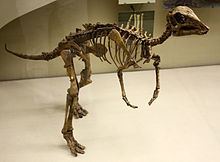Phylum Chordata | Class Sauropsida Family ?Hadrosauridae Rank Genus | |
 | ||
Scientific name Arstanosaurus akkurganensis Similar Barsboldia, Aralosaurus, Auroraceratops, Anserimimus, Aristosuchus | ||
Arstanosaurus (meaning "Arstan lizard" after the Arstan well) is a genus of hadrosaurid dinosaur from the Santonian-Campanian-age Upper Cretaceous Bostobinskaya Formation, Kazakhstan. It has had a confusing history, being considered both a hadrosaurid and a ceratopsid, or both at the same time (chimeric).
Contents
History
The genus was based on a partial left maxilla (holotype AAIZ 1/1 or IZ AN KSSR 1/1), with the lower end of a left femur (AAIZ 1/2) possibly referable. Both were found at Akkurgan-Boltyk near Qyzylorda. This is not much material for naming a new genus, and it was largely ignored until the mid-1990s, when the hypothesis that it was really a ceratopsid appeared. Shortly thereafter, a new revision appeared that showed that the characteristics listed as unusual for Arstanosaurus were really based on perspective, and that the maxilla was from an animal like Bactrosaurus, albeit indeterminate (a dubious name). The femur was uninformative. It was regarded as an indeterminate hadrosaurid in the most recent review.
Diagnostic hadrosauroid remains from the same area have in 2012 been named as Batyrosaurus.
A juvenile skeleton from Mongolia has been attributed to Arstanosaurus, but on what grounds is unknown. It is under study. The informal genus name "Gadolosaurus" has been used for this skeleton. Though the name was made public in 1979, it has never been formally described, and the name is considered a nomen nudum. The name "Gadolosaurus" first appeared in a book by Japanese paleontologist Tsunemasa Saito. It came from a caption to a photo of a juvenile dinosaur skeleton; this small individual was only about a meter long (39 inches). The skeleton was part of an Soviet exhibition of fossils in Japan. Apparently, the name comes from a Japanese phonetic translation of the Cyrillic word "gadrosavr", or hadrosaur, and was never meant by the Russians to establish a new generic name.
Because it is an informal name, with a suspect history, "Gadolosaurus" has not attracted much professional attention. However, it has appeared in many popular dinosaur books, with varying identifications. Donald F. Glut in 1982 reported it as either an iguanodont or hadrosaur, with no crest or boot on the ischium (both characteristics of the crested lambeosaurine duckbills), and suggested it could be the juvenile of a previously named genus like Tanius or Shantungosaurus. David Lambert in 1983 classified it as an iguanodont, but changed his mind by 1990, when it was listed as a synonym of Arstanosaurus. What may be the same animal is mentioned but not named by David B. Norman and Hans-Dieter Sues in 2000; this material, from the Soviet-Mongolian expeditions of the 1970s, had been listed as Arstanosaurus in the Russian Academy of Sciences, but is currently under study for a future description, and more bones have been found in the intervening years. These bones were found at Baishin Tsav and were assigned a tentative Cenomanian age.
Paleobiology
As a hadrosaurid, Arstanosaurus would have been a bipedal/quadrupedal herbivore, eating plants with sets of ever-replacing teeth stacked on each other.
